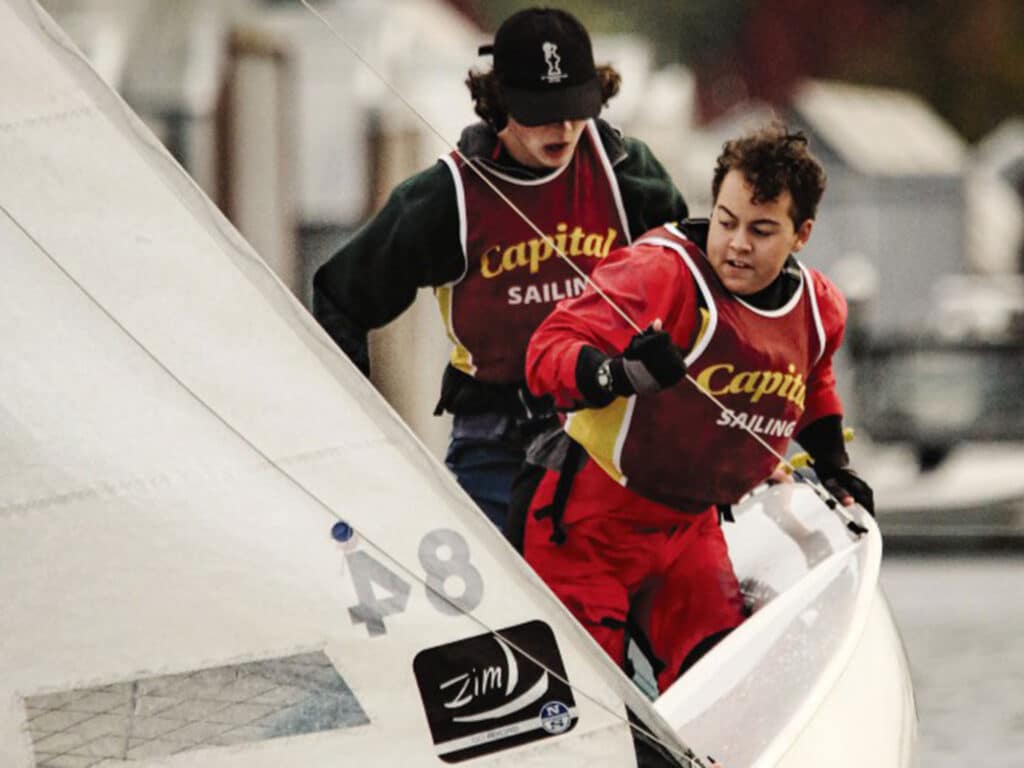
2015, it looked as if the Olympia High School Sailing Team was history. Its numbers had dwindled to three active team members, and if that wasn’t enough, its longtime volunteer coach had recently passed away.
Orion Bird, a sailor in the program of that era, recalls, “It really felt like the program was on the verge of dying.” Enter Sarah Hanavan, recently out of collegiate sailing at Western Washington University. She had moved to Olympia, Washington, and started volunteering with the team in the spring of 2015. That coming summer, she had planned to travel.
“Before I left, one of the three team members, Elena Gonick, a junior, invited me to coffee,” Hanavan says. “She told me she had watched kids from other teams who, at the start, were just as good as her, get better. She was frustrated that she had not. And she knew largely why. She said, ‘We’ve had this revolving door of coaches, and I am afraid you’re going to leave, just like the other coaches.’ The fact that she expected I wouldn’t be back for the fall season really pulled at my heartstrings.”
So, before Hanavan left, she got the parents of the three students involved. “I gave them sort of a road map—here’s what you need to do to make the program more viable, because I wasn’t interested in being a perpetual volunteer.”
From there, it went to a committee at the Olympia YC, which had been hosting and supporting the program. And then came a momentous decision. Rather than simply pulling the plug, the yacht club, which at the time was housing the program and managing it, followed Hanavan’s advice and went high-risk, high-reward, shocking the program back to life by creating a full-time paid coaching position that they offered to her when she returned that fall.
To say the club made the right move would be a dramatic understatement. In only five years, the Olympia race team numbers, which include Opti sailors, Laser sailors and the high school team, skyrocketed to 70.
The high school team, which now has around 45 team members, has won the Pacific Northwest district fleet championship three times, the district championship twice, and qualified for the Interscholastic Sailing Association national championships five years in a row. While not a powerhouse on the national level, they have had success there, breaking into the top 10 twice. But their real success is “off the field,” and the Olympia program has become a model for success at the high school sailing level by a metric other than just stellar regatta results.
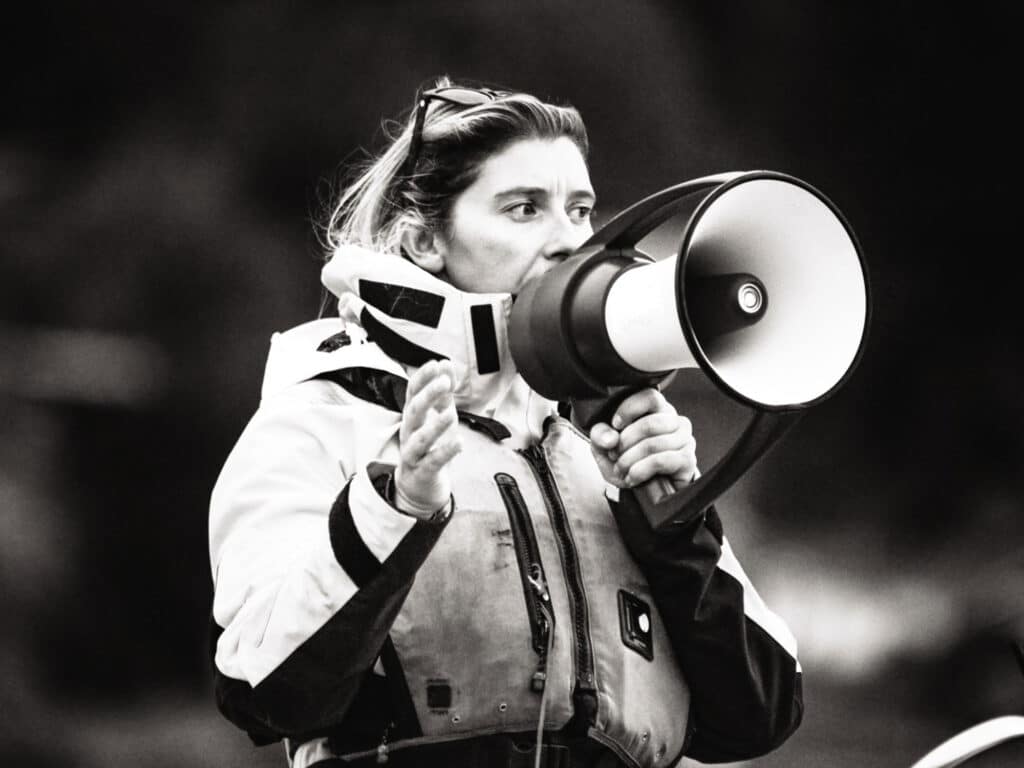
Given that history, I wasn’t quite sure what to expect as I climbed the exterior steps to the main room at Olympia YC. An office to one side with “Olympia Community Sailing Executive Director” stenciled on the door? Perhaps a sign pointing to another building that housed the organization? The door was locked, but I knocked, and a kindly, older woman opened the door a bit and inquired as to what I wanted.
“I’m looking for Sarah.”
“Oh,” she said, opening the door all the way. “She’s over there,” pointing toward two women on the far side of the room. They were at a single round table. One, Hanavan, was seated and on her cellphone, while the other, Niki Alden, the program’s director of education and outreach, was standing to one side. While I waited for her to finish her call, I introduced myself to Alden.
“The whole northwest district seems to come to Sarah for advice,” she said, nodding toward Hanavan, who acknowledges my arrival with a fleeting smile. “We’ll say, ‘We’ve really got to plan the regatta,’ or something like that, and then she’ll get a call from another coach. She eventually hangs up, we start to work, and five minutes later, a different coach calls.”
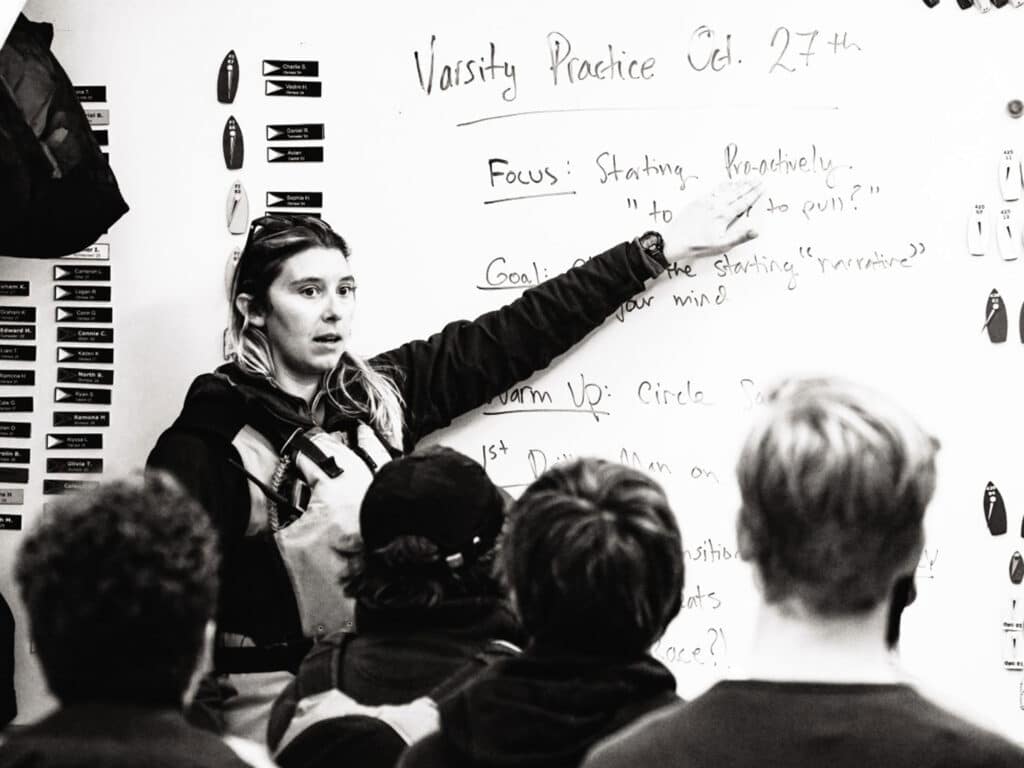
It’s clear why. Watching her work with kids from seventh grade up through seniors is like watching a master class in teaching. Example: It’s JV practice day. In the boathouse—a small, nondescript, single-car garage-size floating building at the junction of a couple of the Olympia YC docks—a sophomore girl approaches her and with little hesitation says, “I’d really like to skipper in the team race this weekend.”
I can see the wheels grinding in Hanavan’s head, and without even knowing the young sailor and seeing Hanavan’s pause, I’m guessing this will be a big reach for the girl. But rather than flat-out telling her, “No, you don’t have enough experience,” she briefly explains how team racing is quite different from fleet racing and then asks, “Do you think it might be better to skipper some more fleet races first?”
With no disappointment, the girl smiles, nods her head and says: “OK. That makes sense. I’ll do that.”
Everyone is happy. Class dismissed.
More JV sailors arrive, and they are changing and rigging their boats at a glacial pace. Rudders are casually removed from their racks and carried over to the boats, then a return trip for the sails. A few are engaged in conversation, and only a couple are actively gearing up for today’s practice. None of it escapes Hanavan’s watchful eyes.
“The varsity does this in about 12 minutes,” she quietly tells me in a tone teetering between embarrassment and frustration. It gets dark early in October. Practice time is burning. Finally, she’s had enough and calls the team together in the boathouse. “I know we need to get out on the water, but we have something more important to talk about,” she says. “Why is it taking so long to change and rig the boats?”
Cue a pregnant pause. Then, “What do you think we should do?”
Note: “We,” not “you.”
Hands quickly go up, and ideas are offered. One suggests they need a greater sense of urgency. Clearly, the strongest answer, and she jumps right on it. “What would a greater sense of urgency mean?” And a discussion ensues until everyone appears to be on the same page.
It’s all part of what junior Liam O’Connell says is their team DNA. “What Sarah preaches is that every year is like a new cell in the body, yet the body is the same because we always pass down this mantra of being a team, not a bunch of individuals. We’re all in this together.”
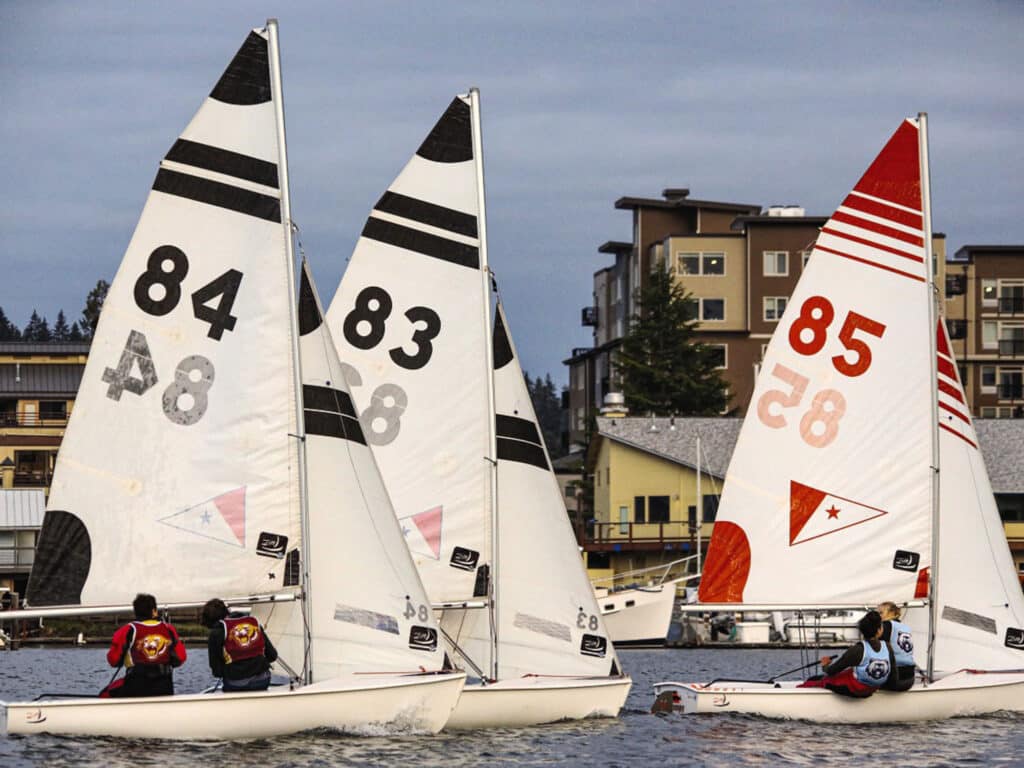
That idea is instilled in the first week of practice. “We don’t sail for the first four or five days of the season,” Hanavan tells me. “We spend those days working on the boats, cleaning, repairing sails, etc. They’re taking care of the boats, even if it’s beautifully sunny and there’s a great wind. Sometimes, they get a little frustrated doing that, but it’s teaching them about ownership of equipment, taking care of the things they use every day that they don’t personally own.”
This sense of ownership is long-term. At regattas, teams bring their own boats, and with a round-robin format, each team ends up sailing other teams’ boats. “As the boats come into the dock for rotation, you always see the Olympia kids rushing down the docks ahead of everyone else to catch the boats,” Alden says. “They want to be sure nothing happens to them.”
OK, the boats are ready. Is it time to get on the water yet? Not quite.
“We then spend a couple of days setting goals and values as a team,” Hanavan says. “Kids break into small groups and talk about what’s important as student athletes and teammates, and what would benefit the team. Then we come together as a complete group, which the coaches facilitate, and do the same thing.”
Out of this often comes a poster that is typically hung in the boathouse, summarizing their conclusions. “It takes on different forms from year to year,” she explains, but the basic themes are similar: time management; respect for oneself, competitors, parents and coaches; how do we treat teammates from different backgrounds; and, since it’s a coed sport, how do we respect female competitors?
“Then we have a template we can point to for the rest of the season, saying these are your values, this is what you told us. It’s our job to facilitate and provide the consistency to enable them to live by those values. It’s always a really powerful conversation to have with either a team or individual. You end up saying: ‘It doesn’t really seem like we’re adhering to our values here. What’s going on?’ It’s a situation where they created the values themselves, now they have to own it.”
The Olympia YC program operates four to five high school teams that practice together. The largest numbers come from Olympia HS, which has over 20 members, and Capitol HS, which are the two closest schools. Three or four other schools participate, but with only a few sailors. However, in terms of programming, they’re all part of the same squad. And that’s encouraged in the Northwest.
“The national high school sailing organization allows regions to set up their own systems to promote growth,” Hanavan explains. “There are regions where you must have a full roster from any one school to compete, but here, we have lower-key, nonranking events for kids, which allows kids from different schools to sail on the same team.”
Without that, those from smaller schools who can’t field complete teams wouldn’t be able to compete. And everyone seems to be out there wanting to do just that. As I hang out in the coach boat with Hanavan, who is working with the JV team, a group of Laser sailors are also practicing, as are some beginning Opti sailors under Alden’s tutelage—not officially part of the team but clearly destined for that a few years down the road.
Yet what stands out about the Olympia sailing team is how they view competition. “We did a survey of our sailors a while back, and do you know what the No. 1 reason they gave for being on the team?” Hanavan asks. “The car rides, traveling to and from regattas, hanging out with friends between races (a product of the boat-rotation format), which allows them to socialize a lot more than being on the water all day. Kids don’t care so much about sailing a fast boat. What they care about is the camaraderie, the friendships. We have kids who do the 420 or Laser Nationals, but they all come back to high school sailing. They crave that traditional high school experience.”
She’s right. In speaking to a handful of team members, both JV and varsity, about what draws them to the team and what keeps them coming back, competition is only mentioned when I prompt them about it. Varsity sailor Sophia Hubbard is a junior who has been sailing since around age 9. She says: “Sarah has focused more on the relationships and people in the boat, rather than going out and trying to win. If winning is a side effect, that’s fine.”
North Berebitsky, a freshman on the JV team, says: “When I started sailing, which was just this season, I thought I had to do my best to get a high place—that was the goal. Now I know it’s more about the experience.”
Alyssa Leong agrees. “When I went to my first regatta, I quickly realized that I’m not there to win. I’m there to be with my team.”
And that’s led to a close-knit group of sailors—friends, really. O’Connell, who is one of the team captains, says, “The reason I keep coming back here season after season is it just feels like another family.”
“I think our program is doing something similar to a lot of other programs,” Hanavan says, “but that’s not what makes the headlines. It’s race results and performance in big events in complicated classes, not having a robust, 70-kid high school program. You don’t make headlines just because you have a bunch of happy high schoolers, many from families who have never sailed. It’s kind of like this sleeper entity that’s happening and growing. Where else can you bring kids with diverse social, economic and racial backgrounds into our sport?”
Like most community sailing programs, Olympia maintains a strong scholarship program, providing support to families who find the $400 cost for a two-month racing period out of reach. “I was one of those kids who couldn’t fully afford the cost of sailing while in middle school,” Orion Bird says, “but I was fortunate enough to get a scholarship that allowed me to sail and afford the gear you need to sail.”
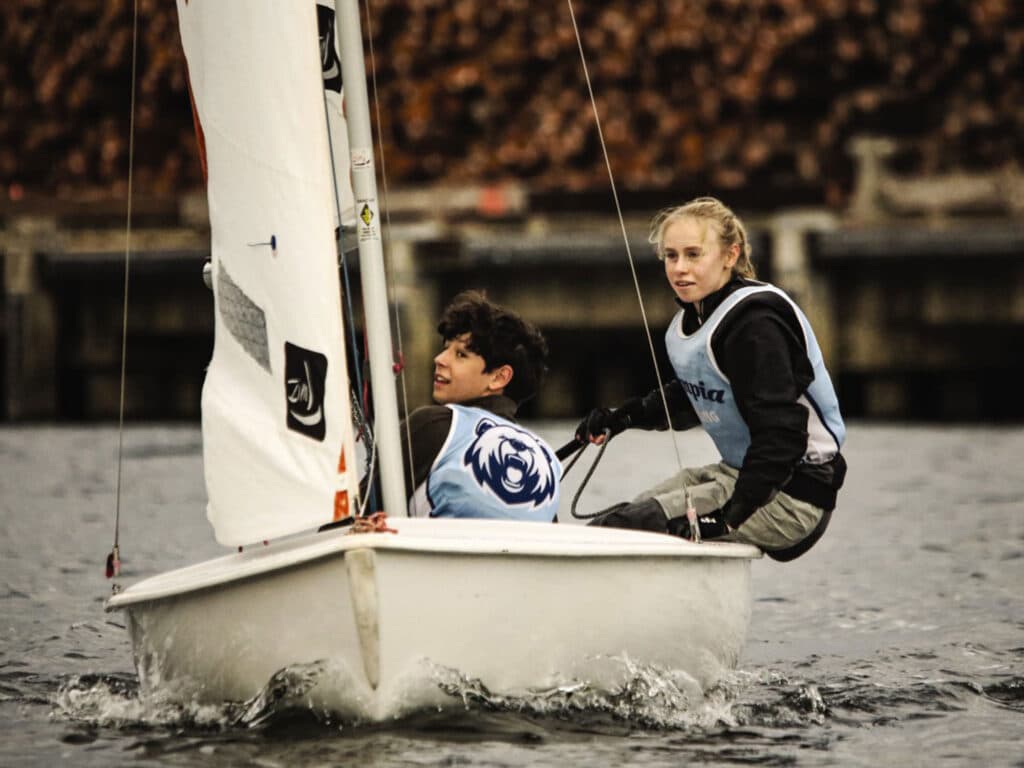
Now, several years out of high school, Bird is on the docks during my visit, coaching the beginning Opti sailors. If sailing programs exist to create lifelong sailors, he’s the poster child.
“I’m not going to lie—I’m an extremely competitive person,” Hanavan says. “Winning is a component of what we want to happen, but it’s a byproduct. It’s a good byproduct. It’s not that we don’t want to be competitive or produce athletes who can win and go to championships. But at the end of the day, that’s not as important as them being quality people. If we had to pick one or the other, we’d always pick quality people first. If winning is a product of that, great.”
So, how do you do both? “I’ve been a part of programs that fixate so much on exposure and experiences, there’s no structure for pursuing that grand goal of competitive success, and I see kids lose interest. Competition can provide you with that if you do it in a good way. As a coach, I can say that our success as a team has been every championship won, regionally. I’ll never forget those, and going to nationals has been wonderful, and as a coach, you feel accomplished. But the best moments I’ve ever had as a coach are going to lunch with kids who graduated and hearing about their adult lives and how happy and well-adjusted they are. That feels better than any trophy our team has won. As a coach, I can genuinely tell the team, ‘I don’t care about you guys winning. That’s great and awesome, and let’s pursue that, but I’d rather just meet up with you when you’re 21 years old and talk about your life and how you’re a happy person, rather than someone who is so fixated on winning that they’re burnt out.”
Such an approach is no doubt part of the reason why the Olympia race program is where it is today. The program has grown large enough that, recently, the host Olympia YC has reluctantly had to cap the amount of space available to the team. And as part of that growth, the Olympia Community High School program became a 501(c)(3) three years ago, taking the management weight off the shoulders of the yacht club.
And while the club’s facilities have space limitations, the program has access to a second site on the other side of a nearby peninsula and often sails Lasers out of there. But the real long-term solution, as with any community sailing center, is to find a chunk of land and build its own facility. In the coach boat with Hanavan, watching the varsity team practice on my final day there, she points across the bay to an unused piece of property with dilapidated buildings on it, about a half-mile away. “I’d love to find a way to get that piece of land,” she says, “but that means a lot of time and some generous benefactors, both of which are in short supply.”
Since the real priority is water access, which they have, that white plastic table in the Olympia YC clubhouse will have to suffice for now. With the continuity of a coach who’s been entrenched for eight years, and a program that seems to have struck the perfect balance between competition and social interaction, they’re in a fine place. And that sailor who helped convince Hanavan to stay, Elena Gonick? She went on to sail at Tufts and graduated in 2020. Just one of a number of Olympia sailing success stories to come.









